Stryer | Images Click on one of the thumbnails below to see the corresponding gallery of photos. Then, click on the arrows in the upper right corner to go full screen. In the gallery of photos, click on the one in the upper left corner to start a manual slide show.
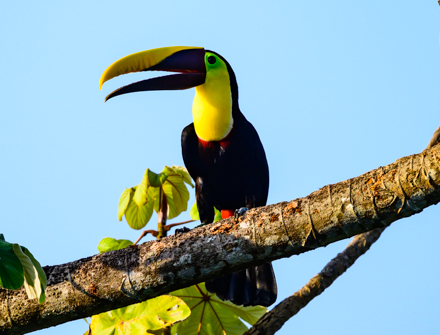 Costa Rican Wilderness Adventure displays images taken on our one-week trip to three wildlife preserves in the southern part of this richly biodiverse country. At Tiskita Jungle Lodge, near Punta Banco, we savored native fruits, observed squirrel monkeys during the day and fluorescent scorpions at night, and delighted in the mating dance of male manakins. We flew north to Playa Sur, where we were awed by mysterious huge stone spheres dating back to 500 BCE before taking a splendid boat ride on the Sierpe River, a treasure trove of birds (herons, warblers, kingfishers, and a well camouflaged potoo) and other wildlife. The highlight was seeing a troop of white-faced Capuchin monkeys playing in the bamboo at water’s edge. On the following day, we saw sixteen sloths and a troop of howler monkeys, thanks to amazing spotting by our top-notch guide Alex Arias. Finally, at San Gerardo de Dota in the Talamanca Mountains, we were very fortunate to see resplendent quetzals entering and leaving their nests.
Costa Rican Wilderness Adventure displays images taken on our one-week trip to three wildlife preserves in the southern part of this richly biodiverse country. At Tiskita Jungle Lodge, near Punta Banco, we savored native fruits, observed squirrel monkeys during the day and fluorescent scorpions at night, and delighted in the mating dance of male manakins. We flew north to Playa Sur, where we were awed by mysterious huge stone spheres dating back to 500 BCE before taking a splendid boat ride on the Sierpe River, a treasure trove of birds (herons, warblers, kingfishers, and a well camouflaged potoo) and other wildlife. The highlight was seeing a troop of white-faced Capuchin monkeys playing in the bamboo at water’s edge. On the following day, we saw sixteen sloths and a troop of howler monkeys, thanks to amazing spotting by our top-notch guide Alex Arias. Finally, at San Gerardo de Dota in the Talamanca Mountains, we were very fortunate to see resplendent quetzals entering and leaving their nests.
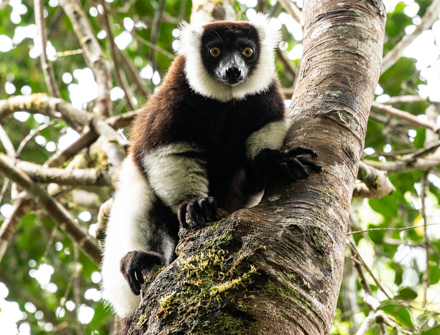 Madagascar: Island of Unique Life displays images from our rewarding trip to Madagascar, superbly led by Matt and Toky. The separation of this land from Africa 150 million years ago enabled it to become a laboratory of adaptive radiation, as exemplified by the evolution of many lemur species that occupy distinctive ecological niches. At Andasibe National Park, we saw the indri, the largest lemur, and heard its piercing call. On night walks, we spotted the mouse lemur and other reclusive nocturnal creatures. At Ranomafana National Park, we observed the greater bamboo lemur and visited the Centre ValBio, a top-notch laboratory that studies and protects biodiversity. From these rain forests, we headed west, where we saw the highly social ring-tailed lemur and explored the fauna and flora of an arid region. At Anjajavay Nature Reserve on the Indian Ocean in the northwest, we delighted in the bouncing movements of the coquerel sifaka. What a great privilege to meet the warm Malagasy people and savor their incredibly rich wildlife!
Madagascar: Island of Unique Life displays images from our rewarding trip to Madagascar, superbly led by Matt and Toky. The separation of this land from Africa 150 million years ago enabled it to become a laboratory of adaptive radiation, as exemplified by the evolution of many lemur species that occupy distinctive ecological niches. At Andasibe National Park, we saw the indri, the largest lemur, and heard its piercing call. On night walks, we spotted the mouse lemur and other reclusive nocturnal creatures. At Ranomafana National Park, we observed the greater bamboo lemur and visited the Centre ValBio, a top-notch laboratory that studies and protects biodiversity. From these rain forests, we headed west, where we saw the highly social ring-tailed lemur and explored the fauna and flora of an arid region. At Anjajavay Nature Reserve on the Indian Ocean in the northwest, we delighted in the bouncing movements of the coquerel sifaka. What a great privilege to meet the warm Malagasy people and savor their incredibly rich wildlife!
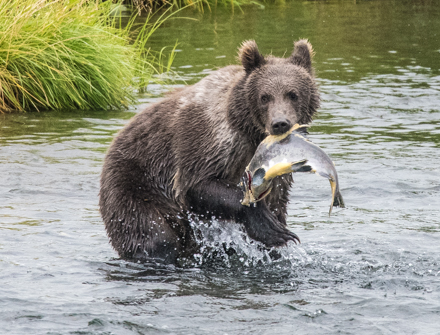 Grizzly Bears & Running Salmon displays images from our four-day visit to the Kodiak Brown Brown Center, a remote wilderness lodge on Karluk Lake superbly operated by native Alutiiq people. Large numbers of sockeye and pink salmon were running upstream in nearby waters to spawn near where they were born. Their abundance attracted many grizzlies, who were avidly fishing streams bubbling with migrating salmon. We were privileged to see fifteen grizzlies -- mothers with two cubs, young and adolescent bears, but no mature males -- in their native habitat. Many eagles too fed on the migrating salmon, and gulls fed on scraps left by grizzlies. A highlight was seeing pairs of mating salmon prepare algae-free sites at the bottom of quiet waters, called redds, where they would soon deposit eggs and milt. Our expert guide Jen brought us to sites where we could observe bear behavior for hours without disturbing them. The lodge provided waterproof gear, enabling us to keep dry during three days of rain.
Grizzly Bears & Running Salmon displays images from our four-day visit to the Kodiak Brown Brown Center, a remote wilderness lodge on Karluk Lake superbly operated by native Alutiiq people. Large numbers of sockeye and pink salmon were running upstream in nearby waters to spawn near where they were born. Their abundance attracted many grizzlies, who were avidly fishing streams bubbling with migrating salmon. We were privileged to see fifteen grizzlies -- mothers with two cubs, young and adolescent bears, but no mature males -- in their native habitat. Many eagles too fed on the migrating salmon, and gulls fed on scraps left by grizzlies. A highlight was seeing pairs of mating salmon prepare algae-free sites at the bottom of quiet waters, called redds, where they would soon deposit eggs and milt. Our expert guide Jen brought us to sites where we could observe bear behavior for hours without disturbing them. The lodge provided waterproof gear, enabling us to keep dry during three days of rain.
 Canadian Arctic Adventure displays images from a one-week trip to the Northwest Territories in late August and early September 2017. Our photographic workshop, led by Robert Berdan, an accomplished nature photographer, began in Yellowknife, where were treated to a splendid aurora above a pristine lake. On the next day, we hiked to picturesque Cameron River Falls, and then saw moonrise and aurora displays after dinner. Our flight 200 miles north on a Twin Otter floatplane over Canadian Shield terrain brought us to Peterson’s Point Lake Lodge (65.3478N, 114.0322W), where we experienced taiga and tundra at a remote unspoiled setting for five days. The ground was covered with cranberries, bearberries, blueberries, crowberries, and many species of mushroom. Autumn had started, made vividly evident by the red leaves of bearberries and the colors of arctic dwarf birch. The wildlife highlight was seeing for more than ten minutes a white arctic wolf in the hunting mode.
Canadian Arctic Adventure displays images from a one-week trip to the Northwest Territories in late August and early September 2017. Our photographic workshop, led by Robert Berdan, an accomplished nature photographer, began in Yellowknife, where were treated to a splendid aurora above a pristine lake. On the next day, we hiked to picturesque Cameron River Falls, and then saw moonrise and aurora displays after dinner. Our flight 200 miles north on a Twin Otter floatplane over Canadian Shield terrain brought us to Peterson’s Point Lake Lodge (65.3478N, 114.0322W), where we experienced taiga and tundra at a remote unspoiled setting for five days. The ground was covered with cranberries, bearberries, blueberries, crowberries, and many species of mushroom. Autumn had started, made vividly evident by the red leaves of bearberries and the colors of arctic dwarf birch. The wildlife highlight was seeing for more than ten minutes a white arctic wolf in the hunting mode.
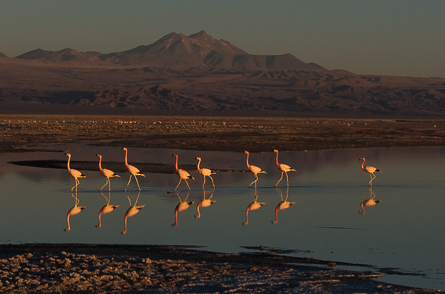 Contrasting Ecosystems: Atacama Desert and Peruvian Amazon displays images taken on a two-week trip to Chile and Peru in late August and early September 2016. San Pedro de Atacama, in the high, dry, cold desert of Chile, was our base for delighting in flamingos foraging in the salt lakes and vicunas grazing on golden grasses in the beautiful altiplano region. The Milky Way and countless other stars in the clear night sky were awesome. So different was the low, wet warm Amazon. We drove from Cusco to the Cloud Forest of Manu National Park, and to Atalaya, where we boarded a boat for a 7-hour ride on the Madre des Dios River to the superbly situated Tambo Blanquillo Lodge. Our excellent guide Darwin introduced us to Amazonian fauna and flora in the jungle and oxbow lakes near the lodge -a capybara, numerous caimans, numerous species of birds, and several giant river otters. Most amazing was watching an ocelot capturing a macaw at the clay lick frequented by these birds.
Contrasting Ecosystems: Atacama Desert and Peruvian Amazon displays images taken on a two-week trip to Chile and Peru in late August and early September 2016. San Pedro de Atacama, in the high, dry, cold desert of Chile, was our base for delighting in flamingos foraging in the salt lakes and vicunas grazing on golden grasses in the beautiful altiplano region. The Milky Way and countless other stars in the clear night sky were awesome. So different was the low, wet warm Amazon. We drove from Cusco to the Cloud Forest of Manu National Park, and to Atalaya, where we boarded a boat for a 7-hour ride on the Madre des Dios River to the superbly situated Tambo Blanquillo Lodge. Our excellent guide Darwin introduced us to Amazonian fauna and flora in the jungle and oxbow lakes near the lodge -a capybara, numerous caimans, numerous species of birds, and several giant river otters. Most amazing was watching an ocelot capturing a macaw at the clay lick frequented by these birds.
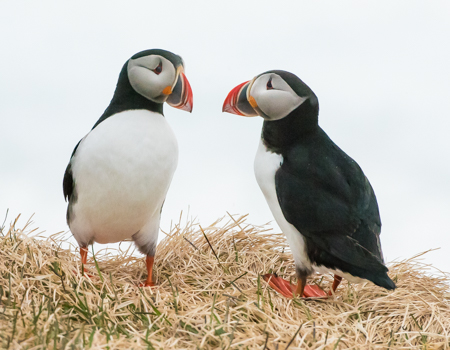 Iceland: Land of Austere Beauty displays images taken on a ten-day trip to Iceland in May 2015. Andrea and I were expertly guided by Christopher Lund, a fine photographer, who drove us to choice locations in his Land Rover. Our adventure began with a visit to the striking Westfjords in northwestern Iceland. Seeing puffins at the Latrabjarg Cliffs in the evening light was one of the highlights of our journey. Two days later, we took the ferry across Breidafjordur to the Snaefellnes Peninsula, where we saw captivating surf-swept lava outcroppings and nesting kittywakes. We next visited historic Thingvellir and the imposing Gullfoss waterfalls on our drive to the beautiful black sand beaches on the south coast near Vik. The last part of our trip was centered at Jokulsarlon (Glacial Lagoon) on the southeast coast, where icebergs are formed by the calving of a tongue of the vast Vatnajokull Glacier. Seeing arctic terns, skua, eider ducks, seals, and newly formed icebergs on the black sand beach at sunset and sunrise was a great experience.
Iceland: Land of Austere Beauty displays images taken on a ten-day trip to Iceland in May 2015. Andrea and I were expertly guided by Christopher Lund, a fine photographer, who drove us to choice locations in his Land Rover. Our adventure began with a visit to the striking Westfjords in northwestern Iceland. Seeing puffins at the Latrabjarg Cliffs in the evening light was one of the highlights of our journey. Two days later, we took the ferry across Breidafjordur to the Snaefellnes Peninsula, where we saw captivating surf-swept lava outcroppings and nesting kittywakes. We next visited historic Thingvellir and the imposing Gullfoss waterfalls on our drive to the beautiful black sand beaches on the south coast near Vik. The last part of our trip was centered at Jokulsarlon (Glacial Lagoon) on the southeast coast, where icebergs are formed by the calving of a tongue of the vast Vatnajokull Glacier. Seeing arctic terns, skua, eider ducks, seals, and newly formed icebergs on the black sand beach at sunset and sunrise was a great experience.
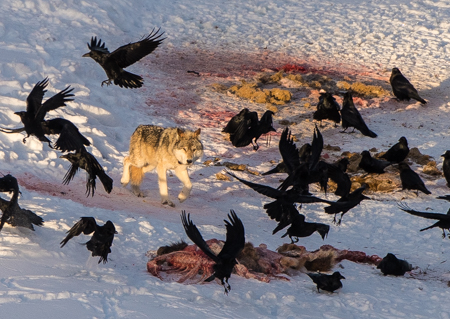 Yellowstone in the Winter displays images taken on a one-week trip to Yellowstone National Park in January 2015. Andrea and I, joined by our friends (who are keen naturalists and fine photographers), spent two nights at Mammoth Hot Springs, two at Old Faithful, and three at Gardiner, a northern gateway. Yellowstone is transcendently beautiful in the winter. The geothermal activity of the region is especially vivid and the early morning frost on fauna and flora is exquisite. We were also awed by the wildlife: bald eagles, trumpeter swans, bison, bigshorn sheep, pronghorn, moose, beaver, muskrat, weasel, fox, coyote, and most striking of all, wolves. We had excellent guides, most notably Tom Murphy, who spotted wolves and other wildlife in the Lamar Valley, a great wildlife sanctuary. Hearing wolves howl to find other members of their pack and seeing them rendezvous before moving together is unforgettable. We were especially fortunate to unhurriedly watch a lone wolf at an elk kill site also visited by ravens and eagles.
Yellowstone in the Winter displays images taken on a one-week trip to Yellowstone National Park in January 2015. Andrea and I, joined by our friends (who are keen naturalists and fine photographers), spent two nights at Mammoth Hot Springs, two at Old Faithful, and three at Gardiner, a northern gateway. Yellowstone is transcendently beautiful in the winter. The geothermal activity of the region is especially vivid and the early morning frost on fauna and flora is exquisite. We were also awed by the wildlife: bald eagles, trumpeter swans, bison, bigshorn sheep, pronghorn, moose, beaver, muskrat, weasel, fox, coyote, and most striking of all, wolves. We had excellent guides, most notably Tom Murphy, who spotted wolves and other wildlife in the Lamar Valley, a great wildlife sanctuary. Hearing wolves howl to find other members of their pack and seeing them rendezvous before moving together is unforgettable. We were especially fortunate to unhurriedly watch a lone wolf at an elk kill site also visited by ravens and eagles.
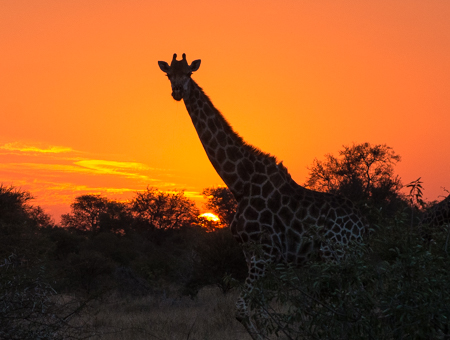 Kruger and Kalahari: Savanna and Desert Wildlife contains images taken on a two-week safari in South Africa in May 2014. Andrea and I were privileged to experience wildlife in three outstanding locales: Lebombo Reserve on the eastern side of Kruger National Park, Sabi Sand Reserve on the western side of Kruger, and Tswalu Game Reserve in the Kalahari. Some highlights were seeing a hyena cub emerge from a den in a cave at Lebombo, a leopardess feeding on an impala carcass with a hyena patiently waiting below the tree at Sabi Sand, and a pack of wild dogs while they were hunting, playing, and preparing a new den for the expected pups of the alpha female at Tswalu. Our observations of the behavior of individual animals were made possible by excellent guiding and tracking in all three reserves, most notably by Ross and Johnson at Ebony Lodge at Sabi Sand. We were thrilled to be fifteen meters away from a dominant male lion roaring (at more than 92 decibels!) to locate his pride.
Kruger and Kalahari: Savanna and Desert Wildlife contains images taken on a two-week safari in South Africa in May 2014. Andrea and I were privileged to experience wildlife in three outstanding locales: Lebombo Reserve on the eastern side of Kruger National Park, Sabi Sand Reserve on the western side of Kruger, and Tswalu Game Reserve in the Kalahari. Some highlights were seeing a hyena cub emerge from a den in a cave at Lebombo, a leopardess feeding on an impala carcass with a hyena patiently waiting below the tree at Sabi Sand, and a pack of wild dogs while they were hunting, playing, and preparing a new den for the expected pups of the alpha female at Tswalu. Our observations of the behavior of individual animals were made possible by excellent guiding and tracking in all three reserves, most notably by Ross and Johnson at Ebony Lodge at Sabi Sand. We were thrilled to be fifteen meters away from a dominant male lion roaring (at more than 92 decibels!) to locate his pride.
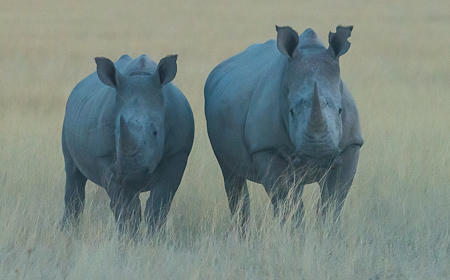 Namibia and Botswana: Primeval and Powerful contains images taken on a three-week adventure in southern Africa in September 2012. Andrea and I traveled on our own in Namibia and then joined Andy Biggs's photo safari in Botswana. We were captivated by the beautiful sand dunes of the Namib Desert, the austere scenery and rock engravings of Damaraland further north, and the profuse wildlife of Etosha National Park and nearby Ongava Game Reserve. The photo workshop was held at Chitabe Camp in the Okavango Delta and then Duma Tau Camp in the Linyanti Game Reserve, two prime wildlife sanctuaries. Seeing rhinos at close range, hearing hippos snort at water's edge near our tented cabin, watching the behavior of a pair of nomadic male lions over three days, and observing wild dogs at the start of a hunt are awesome experiences.
Namibia and Botswana: Primeval and Powerful contains images taken on a three-week adventure in southern Africa in September 2012. Andrea and I traveled on our own in Namibia and then joined Andy Biggs's photo safari in Botswana. We were captivated by the beautiful sand dunes of the Namib Desert, the austere scenery and rock engravings of Damaraland further north, and the profuse wildlife of Etosha National Park and nearby Ongava Game Reserve. The photo workshop was held at Chitabe Camp in the Okavango Delta and then Duma Tau Camp in the Linyanti Game Reserve, two prime wildlife sanctuaries. Seeing rhinos at close range, hearing hippos snort at water's edge near our tented cabin, watching the behavior of a pair of nomadic male lions over three days, and observing wild dogs at the start of a hunt are awesome experiences.
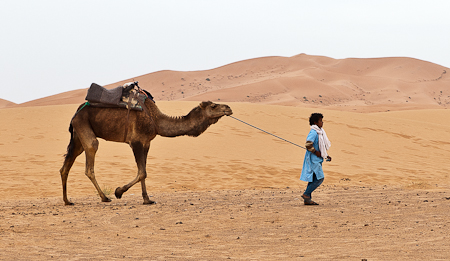 Morocco: the Richness of Diversity contains images taken on a trip in March 2012. My wife Andrea and I joined a vibrant Stanford Travel/Study group on a 17-day adventure that traversed 2000 km of this fascinating land. We visited Rabat, Fes, the Sahara Desert near Erfoud, Merzouga, Ouarzazate, Marrakech, Essaouira, and Casablanca. The landscape is strikingly varied: fertile agricultural basins, sere deserts, snow-capped mountains, and pristine Atlantic beaches. Morocco is also culturally and historically diverse: the Berbers from the Sahara, Muslims from the Middle East, Jews from Jerusalem and Spain, and colonists from ancient Rome, Spain, Portugal, and France. Their confluence fostered outstanding scholarship and generated beautiful crafts, architecture, and design.
Morocco: the Richness of Diversity contains images taken on a trip in March 2012. My wife Andrea and I joined a vibrant Stanford Travel/Study group on a 17-day adventure that traversed 2000 km of this fascinating land. We visited Rabat, Fes, the Sahara Desert near Erfoud, Merzouga, Ouarzazate, Marrakech, Essaouira, and Casablanca. The landscape is strikingly varied: fertile agricultural basins, sere deserts, snow-capped mountains, and pristine Atlantic beaches. Morocco is also culturally and historically diverse: the Berbers from the Sahara, Muslims from the Middle East, Jews from Jerusalem and Spain, and colonists from ancient Rome, Spain, Portugal, and France. Their confluence fostered outstanding scholarship and generated beautiful crafts, architecture, and design.
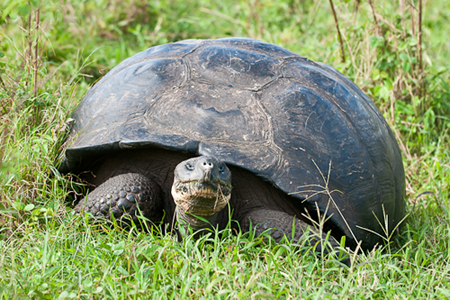 Galapagos: Wildlife and Terrain contains images taken on a trip to the Galapagos Islands in August 2011. My wife Andrea and I, and our daughter-in-law Stacy and granddaughters Rachael and Becca, boarded the Lindblad/National Geographic Endeavor in Baltra and spent a most rewarding week seeing a special ecological niche so rich in wildlife and striking volcanic terrain. We visited Santa Cruz, North Seymour, Rabida, Fernandina, Isabela, Santiago, and San Cristobal Islands. The backdrop was Darwin's extraordinarily revealing exploration of the Galapagos in 1835, a seminal event in the development of his ideas about natural selection and the origin of species. Our visit to the Galapagos was further enhanced by the presence of Jonathan Weiner, author of the engaging book Beak of the Finch, which tells of Peter and Rosemary Grant's outstanding field research showing evolution in action in these islands.
Galapagos: Wildlife and Terrain contains images taken on a trip to the Galapagos Islands in August 2011. My wife Andrea and I, and our daughter-in-law Stacy and granddaughters Rachael and Becca, boarded the Lindblad/National Geographic Endeavor in Baltra and spent a most rewarding week seeing a special ecological niche so rich in wildlife and striking volcanic terrain. We visited Santa Cruz, North Seymour, Rabida, Fernandina, Isabela, Santiago, and San Cristobal Islands. The backdrop was Darwin's extraordinarily revealing exploration of the Galapagos in 1835, a seminal event in the development of his ideas about natural selection and the origin of species. Our visit to the Galapagos was further enhanced by the presence of Jonathan Weiner, author of the engaging book Beak of the Finch, which tells of Peter and Rosemary Grant's outstanding field research showing evolution in action in these islands.
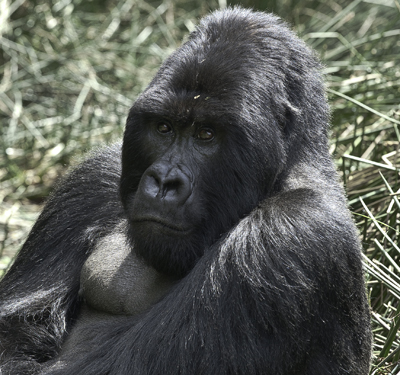 Gorillas, Chimpanzees, and Savanna Wildlife contains images taken on a trip to Rwanda and Tanzania in September 2010. My wife Andrea and I visited Volcanoes National Park in northern Rwanda, Katavi National Park in western Tanzania, and Mahale National Park, on Lake Tanganyika in western Tanzania.
Gorillas, Chimpanzees, and Savanna Wildlife contains images taken on a trip to Rwanda and Tanzania in September 2010. My wife Andrea and I visited Volcanoes National Park in northern Rwanda, Katavi National Park in western Tanzania, and Mahale National Park, on Lake Tanganyika in western Tanzania.
We felt very privileged to see gorillas and golden monkeys in the Virunga Mountains of Rwanda. On our first gorilla trek, we visited the 13-member Hirwa family, and on the second, the 23-member Agashya family. To be within a few meters of a silverback gorilla and his family is awesome. Then, we headed to Katavi National Park, a very rich wildlife habitat in savanna country that has few visitors because of its remoteness. We had wonderful sightings of elephants, lions, hyenas, hippos, eagles, storks, and other wildlife in a very arid setting. The third part of the trip was at Mahale National Park, the home of the habituated M group of chimpanzees, 62 in number. On three mornings, we trekked up the mountain and saw their intense social interactions. We began to recognize individual chimps and learn their life stories. These experiences both enriched our understanding of primate evolution and raised many questions about our genetic heritage.
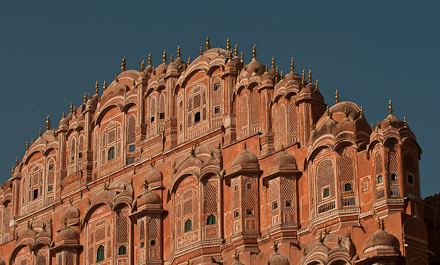 India: Land of Stark Contrasts contains images taken on a trip to northern India in January and Frebruary 2011. My wife Andrea and I visited Delhi, Agra, Fatehpur Sikri, Jaipur, and Udaipur. We were struck by the stark contrasts between beauty and squalor, opulence and poverty, serenity and cacophony. The vibrant colors, intensity of life, rich history, and confluence of different cultures and religions fascinated us throughout our stay. We were enthralled by the splendor and exquisite calligraphy of Mughal palaces and by the elegant carvings of Hindu and Jain temples. Each moment in India was a new encounter. We were exhilirated and exhausted.
India: Land of Stark Contrasts contains images taken on a trip to northern India in January and Frebruary 2011. My wife Andrea and I visited Delhi, Agra, Fatehpur Sikri, Jaipur, and Udaipur. We were struck by the stark contrasts between beauty and squalor, opulence and poverty, serenity and cacophony. The vibrant colors, intensity of life, rich history, and confluence of different cultures and religions fascinated us throughout our stay. We were enthralled by the splendor and exquisite calligraphy of Mughal palaces and by the elegant carvings of Hindu and Jain temples. Each moment in India was a new encounter. We were exhilirated and exhausted.
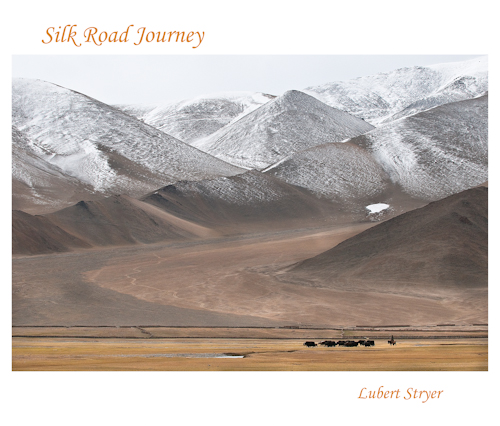 Silk Road Journey contains images taken on a trip to western China in May 2010. My wife Andrea and I visited Urumqi, Kashgar, Tashkurgan, and Turpan in Xinjiang. We then headed to Dunhuang in neighboring Gansu Province, before returning to Beijing.
Silk Road Journey contains images taken on a trip to western China in May 2010. My wife Andrea and I visited Urumqi, Kashgar, Tashkurgan, and Turpan in Xinjiang. We then headed to Dunhuang in neighboring Gansu Province, before returning to Beijing.
Some of the highlights of our trip were: seeing 4,000-year old mummies in the outstanding Xinjiang Regional Museum; visiting the Uigur Old town in Kashgar and riding camels at the edge of the Taklamakan Desert; experiencing the unique Sunday Animal Bazaar in Kashgar; driving on the Karakoram Highway to Tashkurgan, the westernmost town in China, with its splendid views of the magnificent Pamir mountains and glimpses of the Kyrgyz and Tajik peoples; strolling under grape-covered trellices in Turpan, an oasis on the northern Silk Road fed by the waters of the striking Tian Shan mountains; and savoring outstanding Buddhist art at the Mogao caves in Dunhuang and the nearby highly sculptural Mingsha Sand Dunes.
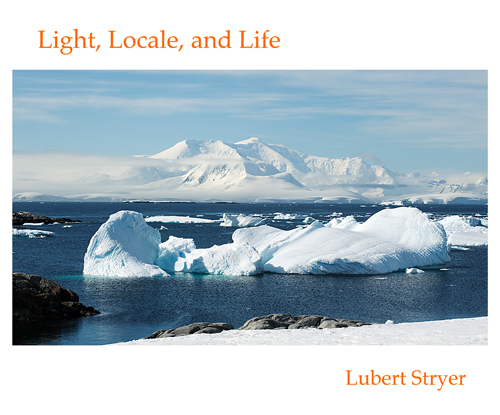 Light, Locale, and Life contains images taken on our travels in recent years to South Africa, the Arctic, Patagonia, Borneo, and the Antarctic, as well as striking places closer to home. They exemplify my keen interest in light, color, and wildlife. I am awed by and seek to convey the beauty of nature and the rich diversity of life in different locales, a vivid expression of the power of evolution.
Light, Locale, and Life contains images taken on our travels in recent years to South Africa, the Arctic, Patagonia, Borneo, and the Antarctic, as well as striking places closer to home. They exemplify my keen interest in light, color, and wildlife. I am awed by and seek to convey the beauty of nature and the rich diversity of life in different locales, a vivid expression of the power of evolution.
These photos were first displayed in the Gallery of the Janelia Farm Research Campus of the Howard Hughes Medical Institute. They are now on permanent display in the Department of Neuroscience, University of Texas Southwest Medical Center, Dallas.
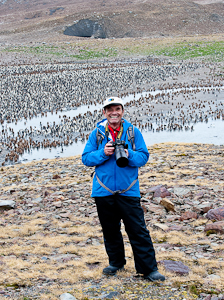 About the photographer:
About the photographer:
Lubert Stryer is a retired Professor of Neurobiology at Stanford University.
"
My retirement from Stanford more than ten years ago has given me the gift of time to intensively pursue two intertwined interests, photography and adventure travel. My fascination with photography began in my teens and developed in tandem with my research passion of many decades, the interplay of light and life."
On location at St. Andrews Bay, South Georgia. Many thousands
of king penguins can be seen in the background.
My Stanford profile.
Copyright 2009-2011 by Lubert Stryer. All rights reserved.
 Costa Rican Wilderness Adventure displays images taken on our one-week trip to three wildlife preserves in the southern part of this richly biodiverse country. At Tiskita Jungle Lodge, near Punta Banco, we savored native fruits, observed squirrel monkeys during the day and fluorescent scorpions at night, and delighted in the mating dance of male manakins. We flew north to Playa Sur, where we were awed by mysterious huge stone spheres dating back to 500 BCE before taking a splendid boat ride on the Sierpe River, a treasure trove of birds (herons, warblers, kingfishers, and a well camouflaged potoo) and other wildlife. The highlight was seeing a troop of white-faced Capuchin monkeys playing in the bamboo at water’s edge. On the following day, we saw sixteen sloths and a troop of howler monkeys, thanks to amazing spotting by our top-notch guide Alex Arias. Finally, at San Gerardo de Dota in the Talamanca Mountains, we were very fortunate to see resplendent quetzals entering and leaving their nests.
Costa Rican Wilderness Adventure displays images taken on our one-week trip to three wildlife preserves in the southern part of this richly biodiverse country. At Tiskita Jungle Lodge, near Punta Banco, we savored native fruits, observed squirrel monkeys during the day and fluorescent scorpions at night, and delighted in the mating dance of male manakins. We flew north to Playa Sur, where we were awed by mysterious huge stone spheres dating back to 500 BCE before taking a splendid boat ride on the Sierpe River, a treasure trove of birds (herons, warblers, kingfishers, and a well camouflaged potoo) and other wildlife. The highlight was seeing a troop of white-faced Capuchin monkeys playing in the bamboo at water’s edge. On the following day, we saw sixteen sloths and a troop of howler monkeys, thanks to amazing spotting by our top-notch guide Alex Arias. Finally, at San Gerardo de Dota in the Talamanca Mountains, we were very fortunate to see resplendent quetzals entering and leaving their nests.













 About the photographer
About the photographer